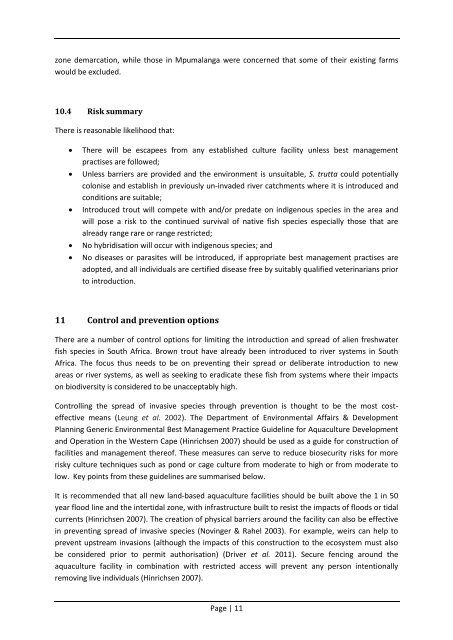Brown trout Salmo trutta - Department of Agriculture, Forestry and ...
Brown trout Salmo trutta - Department of Agriculture, Forestry and ...
Brown trout Salmo trutta - Department of Agriculture, Forestry and ...
You also want an ePaper? Increase the reach of your titles
YUMPU automatically turns print PDFs into web optimized ePapers that Google loves.
zone demarcation, while those in Mpumalanga were concerned that some <strong>of</strong> their existing farmswould be excluded.10.4 Risk summaryThere is reasonable likelihood that:There will be escapees from any established culture facility unless best managementpractises are followed;Unless barriers are provided <strong>and</strong> the environment is unsuitable, S. <strong>trutta</strong> could potentiallycolonise <strong>and</strong> establish in previously un-invaded river catchments where it is introduced <strong>and</strong>conditions are suitable;Introduced <strong>trout</strong> will compete with <strong>and</strong>/or predate on indigenous species in the area <strong>and</strong>will pose a risk to the continued survival <strong>of</strong> native fish species especially those that arealready range rare or range restricted;No hybridisation will occur with indigenous species; <strong>and</strong>No diseases or parasites will be introduced, if appropriate best management practises areadopted, <strong>and</strong> all individuals are certified disease free by suitably qualified veterinarians priorto introduction.11 Control <strong>and</strong> prevention optionsThere are a number <strong>of</strong> control options for limiting the introduction <strong>and</strong> spread <strong>of</strong> alien freshwaterfish species in South Africa. <strong>Brown</strong> <strong>trout</strong> have already been introduced to river systems in SouthAfrica. The focus thus needs to be on preventing their spread or deliberate introduction to newareas or river systems, as well as seeking to eradicate these fish from systems where their impactson biodiversity is considered to be unacceptably high.Controlling the spread <strong>of</strong> invasive species through prevention is thought to be the most costeffectivemeans (Leung et al. 2002). The <strong>Department</strong> <strong>of</strong> Environmental Affairs & DevelopmentPlanning Generic Environmental Best Management Practice Guideline for Aquaculture Development<strong>and</strong> Operation in the Western Cape (Hinrichsen 2007) should be used as a guide for construction <strong>of</strong>facilities <strong>and</strong> management there<strong>of</strong>. These measures can serve to reduce biosecurity risks for morerisky culture techniques such as pond or cage culture from moderate to high or from moderate tolow. Key points from these guidelines are summarised below.It is recommended that all new l<strong>and</strong>-based aquaculture facilities should be built above the 1 in 50year flood line <strong>and</strong> the intertidal zone, with infrastructure built to resist the impacts <strong>of</strong> floods or tidalcurrents (Hinrichsen 2007). The creation <strong>of</strong> physical barriers around the facility can also be effectivein preventing spread <strong>of</strong> invasive species (Novinger & Rahel 2003). For example, weirs can help toprevent upstream invasions (although the impacts <strong>of</strong> this construction to the ecosystem must alsobe considered prior to permit authorisation) (Driver et al. 2011). Secure fencing around theaquaculture facility in combination with restricted access will prevent any person intentionallyremoving live individuals (Hinrichsen 2007).Page | 11
















